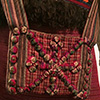Home
 Indian traditional jewels are very beautiful and intricate. Indian women use a lot of jewelry pieces which can be very expensive and made of solid gold adorned with precious and semi-precious stones (for wealthy families) or cheap fake jewels (for poorer women). But, no matter what the material is, Indian jewelry items are usually massive, intricately made, and shiny.
Indian traditional jewels are very beautiful and intricate. Indian women use a lot of jewelry pieces which can be very expensive and made of solid gold adorned with precious and semi-precious stones (for wealthy families) or cheap fake jewels (for poorer women). But, no matter what the material is, Indian jewelry items are usually massive, intricately made, and shiny.
- Details
- Category: India
- Hits: 44590
 Ukraine has some cool traditions regarding folk accessories, especially bags. Ukrainian traditional handbags, shoulder bags, and purses are diverse, bright, and richly decorated. Each of them has its own purpose. Today, it is hard to imagine that a man and a woman can share one bag. But in some regions of the country, folk bags are unisex and still stylish.
Ukraine has some cool traditions regarding folk accessories, especially bags. Ukrainian traditional handbags, shoulder bags, and purses are diverse, bright, and richly decorated. Each of them has its own purpose. Today, it is hard to imagine that a man and a woman can share one bag. But in some regions of the country, folk bags are unisex and still stylish.
- Details
- Category: Ukraine
- Hits: 7057
 Traditional pieces of the male and female national costumes in Korea: ayam, ayngsam, baji, beoseon, binyeo, bokgeon, cheupji, cheolick, chima, chima jeogori, danghye, dangui, dansokgot, darisokgot, deot jeogori, dongjeong, durumagi, gache, gat, gil, git, gojengi, gongbok, goreum, gulle, gun, gunbok, gwanbok, hanbok, heoritti, hogeon, hwal-ot, hwangpo, jebok, jeogori, jeokui, jeonbok, jobok, jokduri, jokki, joseon-oth, juchaui, jumagui, jungchimak, juui, kkachi durumagi, kunghye, magoja, magwae, myeonbok, norigae, obangjang durumagi, onhye, po, ramie, sang, sangbok, sangtu, seolbim, sokchima, soksokgot, sonjjang, wonsam, and yungbok.
Traditional pieces of the male and female national costumes in Korea: ayam, ayngsam, baji, beoseon, binyeo, bokgeon, cheupji, cheolick, chima, chima jeogori, danghye, dangui, dansokgot, darisokgot, deot jeogori, dongjeong, durumagi, gache, gat, gil, git, gojengi, gongbok, goreum, gulle, gun, gunbok, gwanbok, hanbok, heoritti, hogeon, hwal-ot, hwangpo, jebok, jeogori, jeokui, jeonbok, jobok, jokduri, jokki, joseon-oth, juchaui, jumagui, jungchimak, juui, kkachi durumagi, kunghye, magoja, magwae, myeonbok, norigae, obangjang durumagi, onhye, po, ramie, sang, sangbok, sangtu, seolbim, sokchima, soksokgot, sonjjang, wonsam, and yungbok.
- Details
- Category: Korea
- Hits: 11764

If you don’t have a Santa Suit at home, you know, one of those that you can put on and then you're walking around pretending you're Santa. We’re gonna show you how to make a funny one here.
- Details
- Category: United States
- Hits: 15385
 The interesting thing about the United States of America is that most of the citizens are descendants from European settlers, and they often maintain the clothing traditions of their ancestors (English, French, Dutch, Portuguese people). Dutch folk costumes are among the most outstanding and even weird garments for Americans. And you’re able to see such outfits with your own eyes during the Tulip Time Festival held in a Holland city, Michigan, the US, every May.
The interesting thing about the United States of America is that most of the citizens are descendants from European settlers, and they often maintain the clothing traditions of their ancestors (English, French, Dutch, Portuguese people). Dutch folk costumes are among the most outstanding and even weird garments for Americans. And you’re able to see such outfits with your own eyes during the Tulip Time Festival held in a Holland city, Michigan, the US, every May.
- Details
- Category: Netherlands
- Hits: 6178
 The traditional warbonnet of Native American Indians is a sacred headdress. There is a deep philosophical meaning behind each small element of it that can be surprising or even odd for a European observer. We’d like to try to reveal at least some of the secrets and rituals connected to the Native American headdress.
The traditional warbonnet of Native American Indians is a sacred headdress. There is a deep philosophical meaning behind each small element of it that can be surprising or even odd for a European observer. We’d like to try to reveal at least some of the secrets and rituals connected to the Native American headdress.
- Details
- Category: Native American Indians
- Hits: 35859
 The traditional clothes of Peru are woven from the Alpaca wool. This fabric is much warmer and softer than the sheep’s wool, but also hypoallergenic. For millenniums, weaving was one of the main crafts in Peru. So, locals invented and improved many traditional recipes of preparing and dyeing the yarn and weaving the pieces from Alpaca wool. The secrets of Peruvian weaving are useful for anyone who prefers eco-friendly products and clothes.
The traditional clothes of Peru are woven from the Alpaca wool. This fabric is much warmer and softer than the sheep’s wool, but also hypoallergenic. For millenniums, weaving was one of the main crafts in Peru. So, locals invented and improved many traditional recipes of preparing and dyeing the yarn and weaving the pieces from Alpaca wool. The secrets of Peruvian weaving are useful for anyone who prefers eco-friendly products and clothes.
- Details
- Category: Peru
- Hits: 49062
 You should know one thing about the fashion of the 19th century: there is no such style. Let us show you the fashion trends of every decade of the 19th century, and you’ll understand what we mean. After reading this article you’ll be familiar with such terms as art nouveau, pagoda sleeves, crinolette, bustle, natural form era, etc. Maybe, we could even surprise you with some of the fashion ideas of the 1900s. And you’ll definitely be able to tell the difference between the fashion of various decades of the 19th century.
You should know one thing about the fashion of the 19th century: there is no such style. Let us show you the fashion trends of every decade of the 19th century, and you’ll understand what we mean. After reading this article you’ll be familiar with such terms as art nouveau, pagoda sleeves, crinolette, bustle, natural form era, etc. Maybe, we could even surprise you with some of the fashion ideas of the 1900s. And you’ll definitely be able to tell the difference between the fashion of various decades of the 19th century.
- Details
- Category: Nationalclothing
- Hits: 13571
 Traditional Korean summer clothing is often made from ramie cloth. It is similar to linen by its qualities and fits perfectly in warm and humid climates. Many Asian countries (Japan, China, Indonesia, India, Korea, etc.) used ramie for centuries to make ordinary and luxury outfits. But the craft of producing this “live textile” requires large amounts of time and hard labor. You should definitely see for yourself.
Traditional Korean summer clothing is often made from ramie cloth. It is similar to linen by its qualities and fits perfectly in warm and humid climates. Many Asian countries (Japan, China, Indonesia, India, Korea, etc.) used ramie for centuries to make ordinary and luxury outfits. But the craft of producing this “live textile” requires large amounts of time and hard labor. You should definitely see for yourself.
- Details
- Category: Korea
- Hits: 25688
 At the Marashlyan Photo Studio (situated in Yerevan, the capital of Armenia), one can wear an Armenian costume, listen to Armenian music, and acquire knowledge about traditional Armenian costumes, while being photographed. This business serves its main purpose wonderfully: it brings money to the owners and popularizes the Armenian culture and crafts among ordinary locals.
At the Marashlyan Photo Studio (situated in Yerevan, the capital of Armenia), one can wear an Armenian costume, listen to Armenian music, and acquire knowledge about traditional Armenian costumes, while being photographed. This business serves its main purpose wonderfully: it brings money to the owners and popularizes the Armenian culture and crafts among ordinary locals.
- Details
- Category: Armenia
- Hits: 37966
 Among all the traditional costumes of the Greek islands, that of Crete is particularly pretty. It differs much from the classic Greek outfit. One of our favorite accessories of the Cretan folk clothing is the knife that adds some really authentic features to both male and female dress. And, of course, there are exquisite jewelry pieces made from coins – what Greek female costume goes without them?
Among all the traditional costumes of the Greek islands, that of Crete is particularly pretty. It differs much from the classic Greek outfit. One of our favorite accessories of the Cretan folk clothing is the knife that adds some really authentic features to both male and female dress. And, of course, there are exquisite jewelry pieces made from coins – what Greek female costume goes without them?
- Details
- Category: Greece
- Hits: 64919
 It’s not often that the folklore and traditional costumes are presented at the Fashion Weeks around the world. Most of the designers strive to invent and show something new, to shock and surprise the public. Though, one of Ukrainian Fashion Weeks presented the vintage folk clothes and got really good feedback. Sometimes the latest clothing trends and old clothing traditions get intertwined or merged pretty nicely, don’t they?
It’s not often that the folklore and traditional costumes are presented at the Fashion Weeks around the world. Most of the designers strive to invent and show something new, to shock and surprise the public. Though, one of Ukrainian Fashion Weeks presented the vintage folk clothes and got really good feedback. Sometimes the latest clothing trends and old clothing traditions get intertwined or merged pretty nicely, don’t they?
- Details
- Category: Ukraine
- Hits: 3188
 Guys, do you want to know for sure, which local girls are up for a flirt at the Oktoberfest? There’s one indication only Germans and Austrians know about. Just look at their Dirndl dress (female national costume of Germany and Austria): the knot on the apron shows the marital status of a woman. The knowledge will help you to avoid a fight with an enraged husband.
Guys, do you want to know for sure, which local girls are up for a flirt at the Oktoberfest? There’s one indication only Germans and Austrians know about. Just look at their Dirndl dress (female national costume of Germany and Austria): the knot on the apron shows the marital status of a woman. The knowledge will help you to avoid a fight with an enraged husband.
- Details
- Category: Germany
- Hits: 46200
 The most interesting thing about the craft of embroidery around the world is that there is an endless variety of patterns, stitches, and motifs. Each country has its own features and techniques of embroidery. Hungarian traditional embroidery is usually floral and very colorful. At first glance, it looks rather simple, but take a better look – it’s the details that really matter.
The most interesting thing about the craft of embroidery around the world is that there is an endless variety of patterns, stitches, and motifs. Each country has its own features and techniques of embroidery. Hungarian traditional embroidery is usually floral and very colorful. At first glance, it looks rather simple, but take a better look – it’s the details that really matter.
- Details
- Category: Hungary
- Hits: 13297
Page 60 of 70
